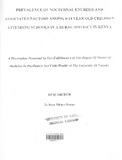| dc.description.abstract | Background: All children start life being incontinent of urine both by day and by night, and as neurological maturation occurs, voluntary urinary control is gained. Children sequentially graduate from voiding by spinal cord reflex, to voluntary cortical bladder control. This is a progressive maturation process. These skills are gained by 4 years during the'day and 5-6 years by night. Primary nocturnal enuresis occurs when there is involuntary passage of urine during sleep by children aged 5 years or older, who have never achieved consistent night time dryness. Secondary nocturnal enuresis occurs when a child who has previously been dry for 6 months or more begins wetting the bed again.
Objectives: To determine the prevalence of nocturnal enuresis and associated factors among 6- 14 year old children attending schools in a rural district in Kenya.
Study design: A school-based cross-sectional study.
Study population: Children aged 6-14 years attending the selected schools.
Study site: Five public primary schools in Mtito-Andei Division, Kibwezi District, Makueni County.
Study period: The study was conducted between June and August 2011.
Study procedure: Five primary schools were selected randomly among the total number of primary schools in the division. Eighty children were then selected from each of the 5 schools using simple random sampling technique, and implemented using paper picking, to make a sample size of 400 children. The sampled subjects were accompanied by the primary investigator and research assistants to their homes, where after consent, a detailed questionnaire was administered to their parents/guardians. Collected data was cleaned, stored and analyzed.
Results: The mean age of the 400 children participating in the study was 10.3 years. Fifty eight children were reported-to have nocturnal enuresis, giving a prevalence of 14.~%. The prevalence of secondary nocturnal enuresis was 4.25% with 17 parents reporting that their children who were initially dry for at least 6 months had resumed bedwetting. Factors found to be significantly associated with nocturnal enuresis included younger age, family set up, family history of bed wetting, voiding habits before bedtime, waking up at night to void, deep sleep and experience of stressful-life events.
Conclusion: The prevalence of nocturnal enuresis among school going children in Mtito - Andei division, Kibwezi district, Makueni county was 14.5%. Factors identified to be significantly associated with nocturnal enuresis in this study population included younger age, family set up, family history of bedwetting, voiding habits before bedtime, waking up at night to void, deep sleep and experience of stressful events in a child's life. | en_US |

